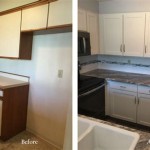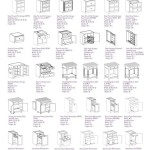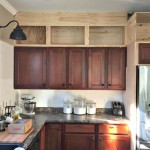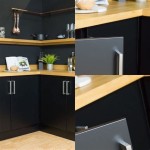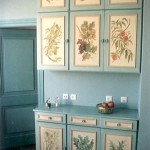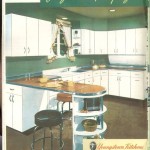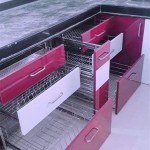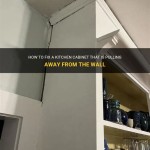Best Looking Kitchen Cabinets: A Guide to Aesthetics and Functionality
Kitchen cabinets are a cornerstone of kitchen design, influencing both the aesthetic appeal and functional efficiency of the space. Selecting the "best looking" kitchen cabinets requires a nuanced understanding of various design styles, materials, finishes, and hardware options, considering not only immediate visual appeal but also lasting value and integration with the overall home décor.
The perception of "best looking" is subjective and dependent on individual preferences and the existing architectural context. Consequently, the optimal approach involves exploring a range of aesthetic possibilities and evaluating them against specific criteria, such as budget, maintenance requirements, and desired style coherence. This article aims to provide a comprehensive overview of key considerations for selecting kitchen cabinets that are both visually appealing and functionally sound.
Understanding Kitchen Cabinet Styles
Kitchen cabinet styles are diverse, reflecting a wide array of historical periods, design philosophies, and material innovations. Identifying a preferred style is a crucial first step in the selection process. Some of the most prevalent and enduring kitchen cabinet styles include:
Traditional: Traditional cabinets often feature ornate details, raised panel doors, and decorative moldings. They evoke a sense of formality and timeless elegance. Common materials include solid wood, often with a stained finish that highlights the natural grain. Traditional kitchens often incorporate elements like crown molding, elaborate hardware, and glazed finishes to enhance the antique or classic feel.
Contemporary: Contemporary cabinets are characterized by clean lines, minimalist designs, and a focus on functionality. They often feature slab doors, frameless construction, and a sleek, uncluttered aesthetic. Materials can range from natural wood to high-gloss laminates, metal, and glass. Contemporary kitchens typically prioritize a streamlined appearance and integrated appliances to maintain a cohesive and modern look.
Modern: While often used interchangeably with contemporary, modern design typically refers to a specific period, roughly from the 1930s to the 1970s. Modern cabinets often feature flat-panel doors, geometric shapes, and a focus on functionality and efficiency. Materials might include wood veneer, laminate, or metal, often with bold colors or contrasting accents. Modern kitchens often showcase the architectural structure and utilize open shelving to create a sense of spaciousness.
Transitional: Transitional cabinets bridge the gap between traditional and contemporary styles, offering a balanced blend of classic and modern elements. They often feature simple shaker-style doors, clean lines, and a neutral color palette. Materials can include a combination of wood and manufactured materials, with a focus on creating a versatile and adaptable design. Transitional kitchens typically incorporate both traditional and modern fixtures to achieve a harmonious and timeless aesthetic.
Farmhouse/Rustic: Farmhouse or rustic cabinets evoke a sense of warmth, comfort, and natural beauty. They often feature distressed finishes, reclaimed wood, and vintage-inspired hardware. Common materials include solid wood, shiplap, and exposed brick. Farmhouse kitchens typically incorporate elements like apron-front sinks, open shelving, and butcher block countertops to create a cozy and inviting atmosphere.
Choosing the appropriate style depends on the homeowner's personal taste, the architectural style of the house, and the desired overall ambiance of the kitchen.
Exploring Cabinet Materials and Finishes
The materials and finishes used in kitchen cabinets significantly impact their appearance, durability, and maintenance requirements. A careful consideration of these factors is essential for selecting cabinets that not only look good but also withstand the demands of daily use.
Solid Wood: Solid wood cabinets are prized for their natural beauty, durability, and timeless appeal. They offer a wide range of grain patterns, colors, and textures. Common wood species used for kitchen cabinets include maple, oak, cherry, and walnut. Solid wood cabinets can be stained, painted, or finished with a clear coat to highlight the natural grain. While solid wood offers superior aesthetics and longevity, it is also generally more expensive than other materials and can be susceptible to warping or cracking in environments with fluctuating humidity levels.
Plywood: Plywood is an engineered wood product made from layers of wood veneer glued together. It is a stable and durable material that is less prone to warping or cracking than solid wood. Plywood is often used for cabinet boxes and door panels. It can be finished with a variety of veneers, laminates, or paints to achieve the desired aesthetic. Plywood offers a good balance of affordability and durability, making it a popular choice for kitchen cabinets.
Medium-Density Fiberboard (MDF): MDF is another engineered wood product made from wood fibers bonded together with resin. It is a smooth and uniform material that is ideal for painting or laminating. MDF is less expensive than solid wood or plywood but is also less resistant to moisture. It is often used for cabinet doors and drawer fronts. MDF offers a smooth surface for painting and is less prone to warping than solid wood but should be used carefully in areas prone to moisture.
Laminates: Laminates are thin layers of plastic or paper bonded to a substrate, such as plywood or MDF. They offer a wide range of colors, patterns, and textures, including wood grain, stone, and metal. Laminates are durable, easy to clean, and resistant to scratches and stains. They are a cost-effective alternative to solid wood or veneer. Laminate cabinets are a popular choice for contemporary kitchens due to their sleek appearance and ease of maintenance.
Veneers: Veneers are thin slices of wood applied to a substrate, such as plywood or MDF. They offer the look and feel of solid wood at a lower cost. Veneer cabinets can be stained, painted, or finished with a clear coat to highlight the natural grain. Veneer is a good option for those who want the aesthetic of solid wood but are concerned about budget or stability.
Finishes: The finish applied to kitchen cabinets plays a crucial role in their appearance and durability. Common finishes include paint, stain, and varnish. Paint provides a uniform color and can be used to create a variety of looks, from traditional to contemporary. Stain enhances the natural grain of the wood and provides a more rustic or traditional feel. Varnish protects the wood from moisture and scratches and provides a glossy or satin finish. The choice of finish depends on the desired aesthetic and the material used for the cabinets.
Selecting Hardware and Detailing
Cabinet hardware and detailing are essential elements that contribute to the overall aesthetic appeal of kitchen cabinets. Knobs, pulls, hinges, and decorative accents can significantly enhance the visual appeal of the cabinets and complement the chosen style and materials.
Knobs and Pulls: Knobs and pulls are available in a wide range of styles, materials, and finishes. They can be used to create a cohesive look or to add a touch of contrast. Common materials include metal, wood, glass, and ceramic. Finishes can range from brushed nickel and stainless steel to antique brass and oil-rubbed bronze. The size and shape of the knobs and pulls should be proportionate to the size of the cabinet doors and drawers. Knobs are typically used for smaller doors and drawers, while pulls are used for larger ones. The style of the knobs and pulls should complement the overall style of the kitchen. For example, traditional kitchens often feature ornate knobs and pulls, while contemporary kitchens typically feature sleek and minimalist designs.
Hinges: Hinges are essential for the functionality of kitchen cabinets. They should be durable, reliable, and easy to adjust. Common types of hinges include concealed hinges, which are hidden from view, and exposed hinges, which add a decorative element. Concealed hinges provide a clean and seamless look, while exposed hinges can add a touch of traditional charm. The choice of hinge depends on the desired aesthetic and the construction of the cabinets.
Decorative Accents: Decorative accents can be used to add personality and visual interest to kitchen cabinets. Common accents include moldings, corbels, and decorative panels. Moldings can be used to frame the cabinets and add a touch of elegance. Corbels can be used to support countertops or shelves and add a decorative element. Decorative panels can be used to add texture and visual interest to cabinet doors. The choice of decorative accents depends on the overall style of the kitchen and the homeowner's personal preferences.
Lighting: Integrating lighting into kitchen cabinets can enhance their functionality and aesthetic appeal. Under-cabinet lighting provides task lighting for countertops, while interior cabinet lighting makes it easier to find items stored inside. Accent lighting can be used to highlight decorative elements or create a warm and inviting ambiance. The type of lighting used should be appropriate for the task and should complement the overall style of the kitchen.
Careful attention to hardware and detailing can elevate the overall look of kitchen cabinets and create a cohesive and stylish kitchen design.

Best Kitchen Cabinets Guide 2024

The Best Inexpensive Kitchen Cabinets 2024

Best Wood For Kitchen Cabinets Cabinet Materials Custom

Our 10 Favorite Kitchen Cabinet Trends For 2024

Top 10 Characteristics Of High Quality Kitchen Cabinets Premier Kitchens And

64 Kitchen Cabinet Design Ideas 2024 Unique Styles

12 Stylish Kitchen Cupboard Designs Design Cafe

Top 10 Characteristics Of High Quality Kitchen Cabinets

15 Stunning Kitchen Cabinet Designs In Singapore With 5 Essential Tips

Best Wood Types For Kitchen Cabinets Cabinet
Related Posts

